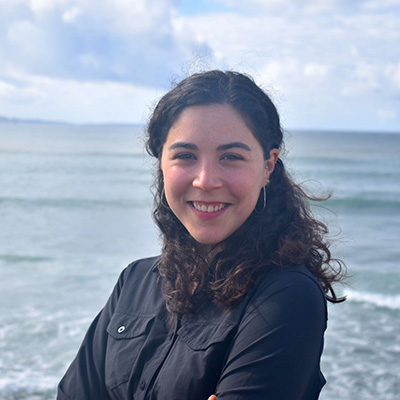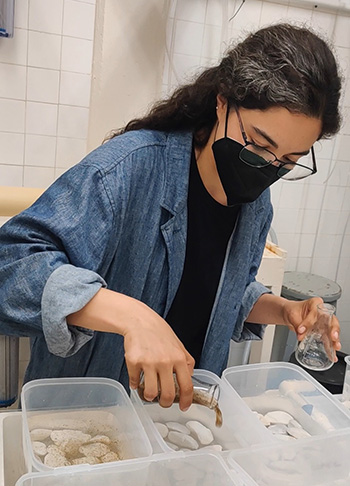Campus News
Kelp restoration project is finalist in LaunchPad pitch competition
Andrea Paz-Lacavex, a graduate student in UCSC’s Coastal Science & Policy Program, leads SPORA, a kelp restoration project in Baja California.




Andrea Paz-Lacavex wants to make the restoration of kelp forest ecosystems scalable and accessible for fishing communities that depend on kelp forest species for their livelihoods. A graduate student in the Coastal Science & Policy Program at UC Santa Cruz, Paz-Lacavex leads a multidisciplinary effort to deploy an innovative kelp restoration technique called “green gravel” in Baja California, Mexico.
Her project—“Socioecology, Planning, and Optimal Restoration of Algae,” or SPORA—is among five national finalists in the 2022 Blackstone LaunchPad Pitch Competition. The finalists gave live pitches at the Startup Grind Global Conference in Silicon Valley on April 12. SPORA, the only startup in the competition with an environmental focus, received $2,500 in funding.
“The Blackstone platform helped me develop the idea for SPORA as an entity that can advance kelp restoration,” Paz-Lacavex said. “I’m proud that it has moved forward to be recognized by Blackstone LaunchPad as a technology solution that can really have an impact.”
To make green gravel, her team settles microscopic kelp spores onto small rocks or gravel to get juvenile kelp plants growing in the lab, attached securely to the rocks. The gravel can then be scattered from a boat over a rocky reef, and the juvenile kelp plants can eventually grow beyond the gravel and become attached to the natural reef.
The green gravel technique was developed by scientists at the Institute for Marine Research in Norway and the University of Western Australia, who used it to restore sugar kelp (Saccharina latissima) in Norway. Paz-Lacavex is adapting their technique for giant kelp (Macrocystis pyrifera), which is a dominant kelp species along the California coast. SPORA is now part of a global consortium, the Green Gravel Action Group, working to implement green gravel techniques around the world.
Last summer, Paz-Lacavex worked with researchers at UC Irvine on a green gravel project led by microbiologist Joleah Lamb. She continues to collaborate with Lamb’s lab to develop protocols for culturing giant kelp in the laboratory.
“My goal is to test the concept of green gravel alongside fishing communities in need of kelp restoration,” Paz-Lacavex said. “Kelp forest ecosystems provide important habitat for many of the species these communities depend on, including fish, abalone, lobster, and urchins.”
Paz-Lacavex grew up in Ensenada in Baja California, where she earned a B.S. in environmental sciences and a specialty degree in environmental management at Universidad Autónoma de Baja California (UABC).
SPORA’s partners include scientists at UABC and at The Nature Conservancy. Paz-Lacavex is using laboratory space at UABC’s Marine Botany Lab, where she is working with phycologists Jose Zertuche and Jose Miguel Sandoval-Gil. She is also working with marine scientists in UABC’s MexCal coastal ecosystem research consortium (Rodrigo Beas and Julio Lorda).
“The cool thing about working in Baja is the opportunity to work with the fishing cooperatives that manage the fisheries in their territory,” she said. “Local collaboration is key to ensuring the success of any restoration project, so we are involving the community from the start.”
At UC Santa Cruz, her advisers are Mark Carr and Peter Raimondi, both professors of ecology and evolutionary biology with expertise in kelp forest ecology and coastal ecosystem management.
“The first time I dove in a kelp forest was with Mark, and I knew then that I wanted to do something to protect this ecosystem,” Paz-Lacavex said. “They’ve really helped me keep this project moving in the right direction as I’ve encountered challenges along the way.”
She said SPORA has the potential to offer green gravel to fishery cooperatives, government agencies trying to improve ecosystem health and social resilience in the face of climate change, as well as to companies that aim to develop sustainable sources of kelp for use in industries such as agriculture, cosmetology, and pharmaceuticals.